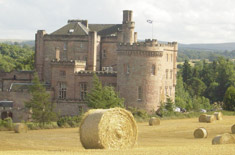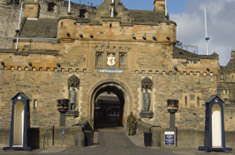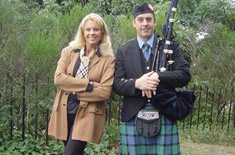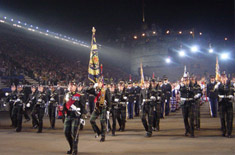Edinburgh and Scottish Countryside
So where do you go to find beautiful countryside, glorious castles, and a fabulous vacation? How ‘bout a wee tour of Scotland, ey? Homeland of at least one of my ancestors, and maybe yours, Scotland is a breathtaking country to explore.
The place to start is in Edinburgh, a fascinating city with a medieval history, but also with a trendiness that just screams today. So we’ve got your tartans and your kilts, we got your haggis and your bagpipes, but we also have your Cuban-Asian Fusion ‘with it’ bistros. Plus, a haunted castle or two just to keep you on your toes.
Edinburgh’s favorite son, Robert Louis Stevenson, wrote, “to travel hopefully is a better thing than to arrive.” Well, arriving in Edinburgh is everything any world traveler could hope for and more! From the heather on the hills that beckon a young boy to play, to world class shopping, to the awe inspiring bridges and castles, Edinburgh is a city that has something for everyone.

This combination of classic and contemporary structures located inside the stone walls, comprise Edinburgh Castle. The castle has served many official functions over the years: as a fortress, a royal palace, a military garrison and a state prison. Today, it still serves as a military headquarters…but it’s primary function as a major tourist destination attracts over a million visitors a year. Maintaining its military significance, with an emotional nod to the past, the Castle grounds are also the final resting place for a man’s…or should I say, soldier’s… best friends.Perhaps no castle in the world has as gallant a history as Edinburgh Castle. If the true meaning of the word “castle” means a walled fortification with a drawbridge and a moat, then Edinburgh definitely qualifies. Since the Bronze Age, an extinct volcano known as Castle Rock has provided shelter, and safety for its storied citizens. Not to mention a terrific view! Perched high on Castle Rock is a collection of buildings dating from the 12th century.
History really comes alive for you when you’re climbing around the castle here. For example, take the Lang Stairs. Lang, meaning “long,” here in Scotland. Back in medieval times, the staircase was the only way to get from the bottom all the way to the top. Can you imagine trying to have a battle, pulling out your swords? Or even trying to haul those big guns up to the top of this spiral? Whew!
Speaking of history, the castle is full of interesting stories. Lots of battles were won and, unfortunately, lost here. In fact, you could spend days, and still not learn the stories of every little sword knick or bullet hole. Not to mention, hear all the stories of the famous inhabitants. For example, the controversial Mary Queen of Scots gave birth to her son, King James IV here…who would later be the one responsible for reuniting the crowns of Scotland and England.
The oldest surviving structure on Castle Rock is St. Margaret’s Chapel, which was built by King David I in the 12th century. It’s a popular spot for local weddings, and always a favorite with the father of the bride, since it only seats 20 people! Standing in front of the chapel, is Mons Meg, a huge and powerful siege cannon from the 15th century that fired 330 pound stones nearly two miles! Ouch! That’s gotta hurt!
Speaking of cannons, the castle’s got quite a collection…one still in use today. Since 1861, members of the Royal Artillery have fired a cannon precisely at one o’clock every day except Sunday. The cannon firing is in exact synchronization with the time ball on top of Nelson’s monument on Calton Hill and Greenwich Mean Time. Originally meant to help sailors check their chronographs, nowadays, it mostly just scares the heck out of unsuspecting tourists walking along Princes Street.

Edinburgh Castle…an impressive glimpse into the heart of the Scots ….a monument dedicated to bravery, loyalty and pride of country. Any city with a castle has to have a legend or two to go along with all that history and tradition, and Edinburgh is no exception.
The legend of Greyfriars Bobby is a tale of determination and devotion, inspiring two books, a movie, a play…and a statue! “Bobby” was a dog, but not just any dog. Bobby’s master was a police officer and Bobby was his eternal companion.
They’re well know in the eighteen hundreds down in the grass market, doing the rounds and making sure all was well in the town. Unfortunately, one winter’s day, Bobby’s master passed away. On the day of the funeral, Bobby led the funeral cortege, which really amazed locals, up into the cemetery, and down to the gravesite.
Bobby was chased out of the cemetery; but the next morning he was there again, and for the second time was locked out of the gates. The third morning was cold and wet, and when the curator saw the faithful dog, in spite of all his scolding, shivering steadfastly on his master’s grave, he took pity on him, and gave him some food. But in Edinburgh, you needed a license to keep a dog, and people knew that Bobby did not have a master; they knew his master had died. So there was a court case as to who owned the dog.
It’s said that royalty were involved and Queen Victoria reputedly said that loyalty such as this dog had shown should be rewarded in typical Victorian style. The dog was made a Freeman of the City of Edinburgh and was to roam the city at will, his license paid for by the government.
Bobby was quite famous in his own time, as well, because in Edinburgh we fired a cannon at one o’clock, and that was a signal to Bobby to get fed. He would trot down to Mr. Treales’s restaurant, still standing, and he’d be fed. But at night, if you wanted to see Bobby, if you wanted to strike up a doggy conversation, you can go to the cemetery, where Bobby watched over his master’s grave for fourteen long years until his demise. The Legend of Greyfriars Bobby lives on today in the pub named after the devoted dog where you can enjoy another one of Edinburgh’s great traditions – a pint of Guinness or a glass of Scotch Whiskey! Here’s to you Bobby!
A popular tourist attraction, the Royal Mile also provides a fascinating insight into the history of the City and of Scotland itself. The Royal Mile, the main drag of yore. The kings and queens used to travel from the castle to the palace along this road. Since the 11th Century lots of famous figures have tread the Royal Mile’s uneven cobblestones. From the famous Mary Queen of Scots and Bonnie Prince Charlie…to the infamous Deacon Brodie, and Robert Louis Stevenson. The Royal Mile boasted the world’s first skyscrapers, with tenements soaring high above the street.
Surprisingly, a mix of different classes all lived together in the same buildings – the wealthier living high up…furthest away from the smell! Today the Royal Mile is a charming street of history and ghost stories –but most of all it’s a living, breathing street of pubs, restaurants and shops, where tourists love to tread!
Robert Louis Stevenson wrote Dr. Jekyll and Mr. Hyde about the infamous Deacon Brodie who lived by the Royal Mile. He was also hung just down the road, too. You can have a drink to his name over at the pub named after him.
Make sure you save some time for a side trip right off the Royal Mile to the Grass Market. Here’s where to find some really interesting architecture and some unusual shops. Hey – I’ve been looking everywhere for chimney sweep supplies!
St Giles’ Cathedral is the High Kirk, or “church”, of Edinburgh, and has been the heart of the city’s spiritual life for the last 900 years. Over a quarter of a million visitors a year come to experience its unique combination of ongoing worship and ancient history. In 1559, controversial minister John Knox split the inside into several different rooms, and for the next 300 years the cathedral housed a police station, a fire station, a school, and a coal store. The Scottish guillotine, the ‘Maiden’, was also housed in the church…yikes! And in one corner was a prison used for, and I quote… “harlots and whores”. Oh my!
Near the street in front of St. Giles’ cathedral, is an outline of a heart set in the cobblestones called the Heart of Midlothian. This marks the spot of the old tollbooth gallows and prison. In the 15th century, criminals used to spit on the doors of the tollbooth. Nowadays, the locals stand on the rim of the heart and spit into it. Hitting the middle brings good luck. Go ahead… “When in Edinburgh! Another quick side trip is to Prince’s Street Gardens where you can find the Sir Walter Scott Monument, honoring Edinburgh’s favorite son and author, along with his favorite dog…Maida!

The Mercat Cross on the Royal Mile marks the center of Old Edinburgh, where royal announcements were made…and still are today! In medieval times, the cross stood in the middle of High Street, but was rebuilt and moved to its present position outside the High Kirk of St Giles in 1885. Hear Ye! Hear Ye!
You know one of the best places to get a great view of the Royal Mile is from Calton Hill, a favorite tourist attraction and home to the Lord Nelson Monument. It’s also where to find what’s referred to as “Edinburgh’s Shame,” the unfinished replica of the Parthenon. At the foot of the Royal Mile, is the Palace of Holyroodhouse, started in 1501 by James IV. A favorite with Queen Victoria, who became a regular visitor here in the 19th century, it’s still the official residence for any royal visitor to Edinburgh, including Queen Elizabeth II! Sort of “Windsor Castle North, I guess you could say!
Castles, castles everywhere. And if you ever thought you might like to spend the night in one, well, Scotland’s the place. For over 850 years, Dalhousie Castle has been home to the Ramsay Family, and has boasted King Edward I, Mary Queen of Scots, and Sir Walter Scott as just a few of the notable overnight guests.
In 1972, the Ramsey family decided to open their home to weary travelers and established Dalhousie Castle as a world-class hotel. Nestled comfortably in the beautiful Scottish Countryside just 7 miles from Edinburgh, Dalhousie Castle is the perfect destination for a luxurious European getaway. There are several time honored Scottish traditions carried on at Dalhousie. One being the playing of the pipes, and you can see and hear how this instrument is played.
For a glimpse into the past, Dalhousie invites their guests to try their hand at Falconry, the sport of kings. Falconry is a sport where you use birds of prey to go hunting. I found out that falconry isn’t just for falcons, but owls and other birds of prey as well, and it all has to do with how important you are!
If you were the king, you’d get the strongest, the fastest and the biggest, which would be the eagle. If you were a town’s folk, you would get the Merlin falcon, which is the smallest British falcon. Unless you were to catch mice for your dinner, then they are completely useless for hunting reasons. But they did use them to catch their food.
Any old castle has to have a ghost or two, and Dalhousie is no exception. So, complete your Castle experience with a ghost story in the Castle’s private chapel. If you have a house about 750 years old, you get atmosphere and you get certain things happening there. This humble castle, of course, is no different from any other. It has one or two, shall we say, visitors from the spirit realm. You’ll be happy to know that they’ve never experienced within the castle foreboding or evil. But they do have a certain female spirit they call Lady Catherine. She’s known as the only mischievous spirit here. I didn’t run into any ghosts during my stay in the castle, maybe next time, I hope.
At the base of the Royal Mile, in the historic port of Leith, is one of the world’s most famous ships, the Royal Yacht Britannia. So, if you’ve ever wondered what it was like to live like a Queen, now’s your chance.
Launched in 1953, the Britannia logged a total of over a million nautical miles, equal to once around the globe for every year she was in service. Traveling from the furthest regions of the South Seas to the deepest divides of Antarctica, the Britannia has helped make The Queen the most traveled monarch in history before being decommissioned in 1997.
Queen Elizabeth was quite involved in designing this yacht. She and Prince Phillip, when they were presented with the original plans for the yacht, decided that it was too ostentatious, too much like a palace. They wanted more of a country house feel afloat, and that’s what you see today. It’s like stepping back in time to the 1950’s. It’s a very relaxed atmosphere, it’s the one place the Queen felt that she could truly relax away from the press, away from prying eyes
Open to the public as a museum since 1998, the Britannia has attracted close to two million visitors and a quick tour of the ship will let you know why it remains one of the most popular tourist destinations in the UK Visitors can view the Royal Bedrooms and Drawing Room and The Sun Lounge, which is where the Queen says she could finally relax. The State Dining Room is available for corporate events and features the same quality of food and service her Majesty enjoyed. The Sick Bay and operating theatre were the most unpopular rooms on the ship during its commission, but they are a favorite among tourists who enjoy their quaint 1950’s instruments and furniture.
The officer’s sleeping quarters gives visitors a feel for what ship life must have been like, as does the Petty Officer’s Mess. The laundry room with its original machinery still functions today and, during its heyday, was the hottest room on the ship with temperatures reaching 120 degrees Fahrenheit. You’ll see the Royal Barge, which the Queen used for shore excursions.
The view from the bridge on Brittania is awesome and helps convey the feeling of power the ship’s captain must have felt. And, finally, the Engine Room, the place where it all happened. With its gleaming chrome and glass instruments and dials, the Engine Room is as dazzling as the Crown Jewels and almost as dear to her Majesty. When Norman Schwarzkopf came down and looked at the engine room he said, “Okay, now I’ve seen the model, where’s the real thing?’ Uh, uh. These engines are the ones that have taken the Britannia over a million miles. The Queen and Prince Phillip took such pride in the engine room they always kept it this pristine and actually came down for a ribbon cutting ceremony when it passed the million mile mark.
Over 400 feet long, 55 feet wide, 140 feet tall, weighing over 5,000 tons and carrying over 300 Royal Yachtsmen and Royal Household Staff, the Britannia was a veritable floating palace and remains a five star visitor attraction where the average tourist can be queen for a day!
Famed for its medieval skyscrapers, historians once dubbed Edinburgh “Europe’s most crowded city” and if you decide to visit during the annual Edinburgh Festival, you’ll know what they were talking about! Every August, six international festivals draw tourists from all over the world for round the clock fun and entertainment. One of the most daring and delightful of these is the world famous, Fringe Festival, during which 668 companies do over 21,000 performances of world-class music, dance, and cutting edge comedy. The word, “fringe” comes from being “outside” the main Edinburgh festival…kind of “off Broadway” you could almost say!
All day every day, actors roam the streets promoting their shows while street performers deliver the entertainment directly to the crowds. With so many shows, all are looking to pull in an audience! And some of these acts are pretty wild! From conventional to controversial, there’s something for everyone! Even for the kids! Trust me…they’ll love it, and so will you!

The highlight of a visit to the Edinburgh Festival takes place after the sun goes down…when all eyes are once again on Edinburgh Castle. At night, the castle is transformed into a magnificent stage, where the main event of the festival unfolds, the Military Tattoo.
With the backdrop of Edinburgh Castle, the Military Tattoo has been called one of the world’s greatest shows. An incredible production, this is being broadcast to over thirty countries. They say once you see the Military Tattoo at the Edinburgh Festival, you’ll never forget it. Since 1950, millions
Emotions run high as the drawbridge opens and the massed bands proceed into the arena, playing anthems of old…paying tribute to Scotland’s glorious and sometimes tragic past. To those Scots performing, it’s an honor to play on this field, once a field of battle. And the word tattoo? It’s actually originated as a call to arms.of visitors come from all over the world to see this amazing summer performance. They join hundreds of proud Scotsmen as darkness falls over the castle; where the night sky is soon filled with spectacular colored lights, the wailing of the pipes and the crackle of the drums.
“Military” is the theme, with bands, drill teams and drum corps participating by invitation from all over the world. A parade of pomp and pageantry, the massed military bands re-enact the presentation of the first Union Jack to King James. For the impressive grand finale, the international cast of 1000 takes the field to perform a theatrical “Queen of My Heart,” closing with “Conquest of Paradise.” Emotions run high, as bands, choirs and audience members raise close to 10,000 voices. Hands and hearts are joined together in a spirit of peace and harmony.
As the image of the lone piper perched high atop the castle wall signals the close of the Tattoo, one is reminded of the words of Edinburgh native Sir Walter Scott: “to all, to each, a fair good night, and pleasing dreams, and slumbers light.”
As our stay in Scotland is coming to a close, I’d like to propose a toast: “Raise a glass of your finest single malt to honor the history and heroes of Edinburgh. The Fringe and the Fortress, The Tartans and Tattoo…The spirit of Old Edinburgh is calling out to you. The cannons and the Kirk…And the writer and the river…The ghost tales of Old Edinburgh are sure to make you shiver! From the palace and the pipers to the monuments and the mile…There’s something ‘bout old Edinburgh that will leave you with a smile. Edinburgh, Old Edinburgh, we raise our glass to thee…A toast to all your merriment, your mirth and majesty. May your fields ever flower, may your castle walls stand strong. I shall keep thee in my memory ‘til I come home where I belong.”
Just remember a few things before you leave. You want something tartan, a bottle of superb scotch, some Scottish lace, and some Scottish shortbread cookies to take back home! Your family will be piping tunes and tales the whole way home!
